Table of contents
- Tips for the maintenance of cooling systems This is how the cooling works
- Advantages of water cooling
- Disadvantages of water cooling
- cooler
- Coolant change
- Thermostat check
- Improvements
- Winter operation
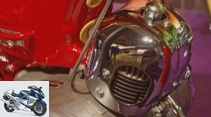
Ralf Petersen
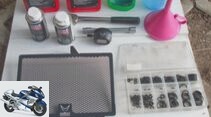



15th pictures
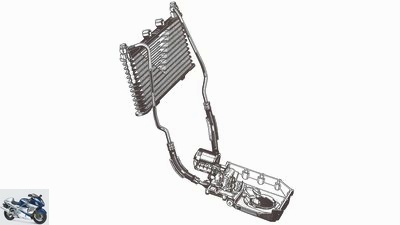
Ralf Petersen
1/15
We explain how the maintenance of a cooling system works.
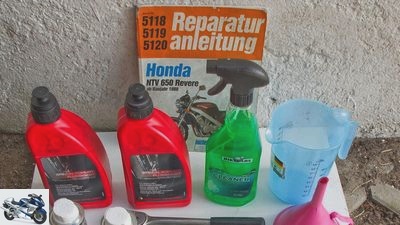
Ralf Petersen
2/15
This is needed for maintenance: repair instructions, coolant, measuring cup, universal cleaner …
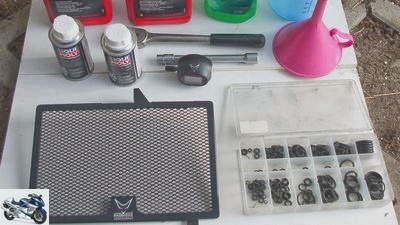
Ralf Petersen
3/15
… Tools, funnels, O-rings / seals, torque wrench / attachment, possibly cooler sealant or cleaner.
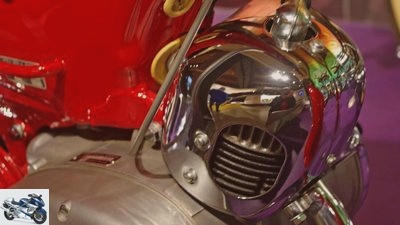
Ralf Petersen
4/15
Not nice, but effective – the fan cooling.
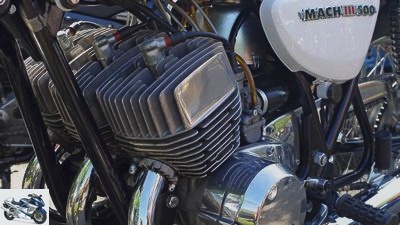
Ralf Petersen
5/15
Particularly sensitive to heat – two-stroke engines.
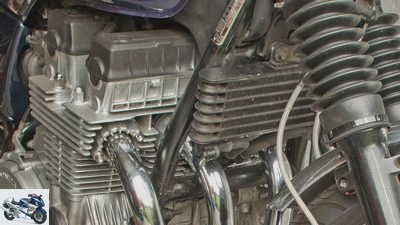
Ralf Petersen
6/15
Small but efficient – oil cooler on a seven-fifty.
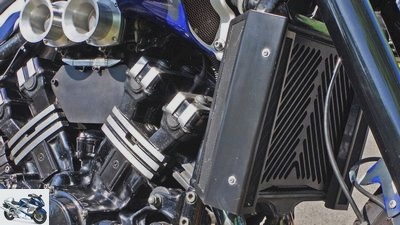
Ralf Petersen
7/15
Big is beautiful – powerful water cooler on a V-Max.
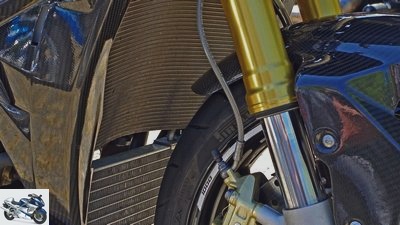
Ralf Petersen
8/15
Two are better than one – combined cooling on a BMW S 1000 R.
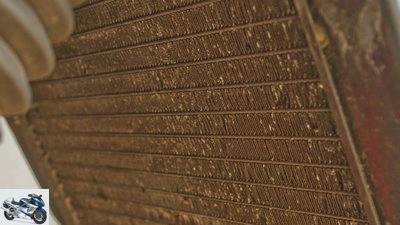
Ralf Petersen
9/15
Please clean – dirty radiator with bent fins.
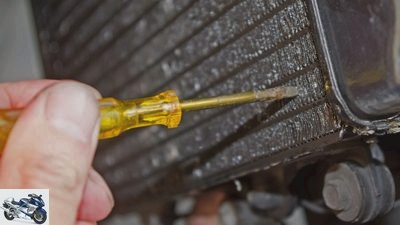
Ralf Petersen
10/15
Very carefully – bend crooked slats straight again.
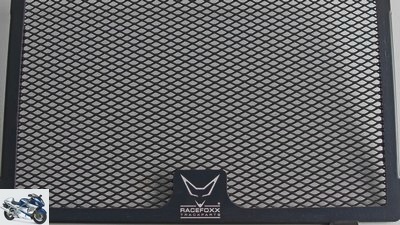
Ralf Petersen
11/15
Good protection through additional radiator grille.
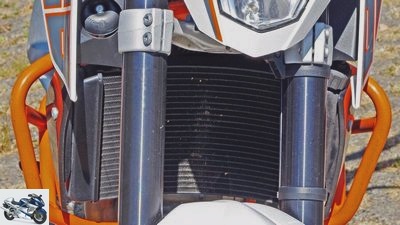
Ralf Petersen
12/15
Better safe than sorry – crash bars protect large radiators.
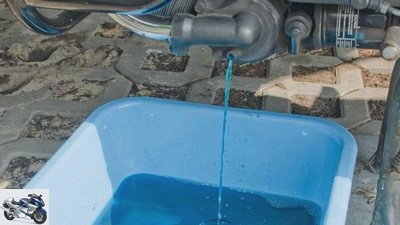
Ralf Petersen
13/15
No challenge – changing the coolant.

Ralf Petersen
14/15
In the event of a problem: radiator cleaner and radiator sealant.
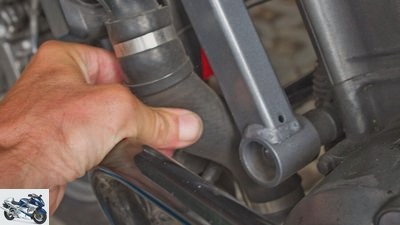
Ralf Petersen
15/15
The air has to get out – light pressure on the hoses.
counselor
workshop
Tips for mechanics: Maintenance of motorcycle cooling systems
Tips for the maintenance of cooling systems
This is how the cooling works
Every internal combustion engine requires cooling, since a considerable part of the combustion energy is given off as heat. The more powerful the motor, the higher the thermal load and the more complex the cooling must be. But how does the maintenance of the cooling system work?
01/29/2021
For a long time, the standard cooling for motorcycles was air cooling, in which most of the heat was dissipated to the ambient air via the cylinder and cylinder head. These motors (often made of thermally conductive aluminum) have large cooling fins and are cooled by the airflow. In smaller machines and especially in scooters without airflow cooling, fan cooling was and is occasionally used, in which a fan wheel directs air to the motor. In four-stroke engines, the engine oil also plays an important role in cooling; it absorbs part of the heat and transports it to the oil pan, which is also cooled by the wind from the wind. Of course, two-stroke engines do not have this option and therefore often have particularly large cooling fins or special air duct systems (e.g. RamAir from Suzuki).
Advantages of water cooling
The steadily increasing engine performance in the last few decades has led to the use of oil coolers in air-cooled engines, in which the absorbed heat is released into the ambient air by a cooler, similar to water cooling. From a technical point of view, the best solution is water cooling / 4 /. The heat generated during combustion is dissipated by a coolant that is located in a closed cooling circuit and circulates between the engine and the radiator with the help of a pump. An external tank serves as an expansion tank and storage tank. Since the thermally particularly stressed areas around the spark plugs and exhaust ducts are optimally cooled, you can increase performance without having to worry about overheating damage. In addition, the water cooling improves the smoothness, reliability and longevity of an engine, also dampens mechanical noise and thus helps to comply with the increasingly stricter limit values for exhaust and noise emissions.
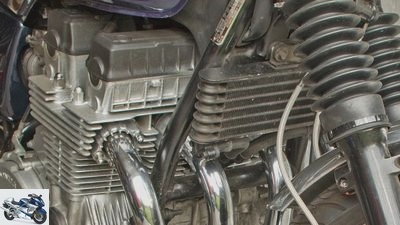
Ralf Petersen
Small but efficient – oil cooler on a seven-fifty.
Another positive aspect is the faster heating of the oil during the cold start phase thanks to the use of a thermostat. The thermostat is closed below 80 degrees Celsius and only a small part of the cooling water can flow through a bypass hole into the cooler and back to the pump. Even after that, the thermostat (bimetal mechanism) does not open suddenly, depending on the temperature, the flow is only released slowly. It is fully open from around 85 degrees Celsius. If the water temperature drops again, the thermostat restricts the flow and the temperature can rise. Water cooling also has advantages when driving slowly or when stationary, as an electric fan built into the cooler provides the necessary air supply if required.
Disadvantages of water cooling
However, water cooling also has disadvantages. A higher technical effort (pump, cooler, hoses, etc.) means additional weight, maintenance effort (coolant change) and potential for errors (leaks). Purists are often bothered by the changed sound of the machine. Some high-performance motorcycles now also have a combination of oil and water cooling with two separate coolers.
cooler
A cooler, regardless of whether it is a water or oil cooler, is basically maintenance-free, but should still be checked for soiling and damage to the fins from time to time. Are the slats namely z. B. bent by falling rocks or contaminated by dirt, insects or rubber abrasion (e.g. from operation on the racetrack), the cooling capacity is significantly reduced. Since the use of a high-pressure cleaner on the motorcycle should be avoided as far as possible, it is best to take a universal cleaner (or similar) and spray the dirty areas with a pump atomizer. After a sufficiently long exposure time, the cooler can be thoroughly cleaned with a soft brush and a light jet of water. If you notice that some of the lamellas are bent, carefully bend them straight with a fine screwdriver or needle-nose pliers. Caution: The lamellas are sensitive and can break if they are bent repeatedly.
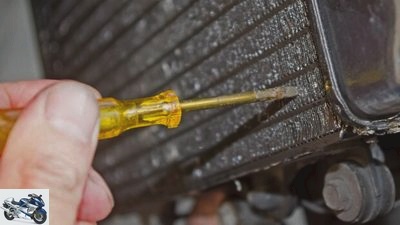
Ralf Petersen
Very carefully – bend crooked slats straight again.
For regular use in the field, the installation of a cooler protective grille is recommended (e.g. from Racefoxx between 45 euros and 85 euros). This can also be done temporarily by simply fixing the protection with cable ties. A protective grille can prevent mechanical damage, but it should not significantly reduce the air throughput, as the cooling performance suffers. Radiators that protrude far from the motorcycle have the problem that they can be damaged quickly in the event of a fall. The radiator can be protected by installing appropriate crash bars. If a cooler regularly loses liquid, you can try to solve the problem with small quantities with the help of a sealant (e.g. cooler sealer from Liqui Moly for around nine euros at Polo). Given the low price, it’s definitely worth a try. Otherwise, all that remains is the search for the leak and, in the worst case, the (expensive) replacement of the cooler.
Coolant change
According to the manufacturer, the coolant should be replaced at certain intervals (usually every two to three years). It consists of a mixture of distilled water, antifreeze and anti-corrosive additives. In racing (because of the risk of slipping after a fall), only water is used as a coolant. Anyone who mixes himself or purchases finished coolant from the trade must know which type is used on his machine (manual / forum). There are silicate-containing (mostly green / blue) and silicate-free coolants (mostly red) that should not be mixed (risk of flocculation). If necessary, it is advisable to flush the system. If it is not changed regularly, it is essential to check the frost protection before winter. To do this, you use a corresponding test spindle, which you can purchase for a few euros in car accessories. Before changing the coolant, it is essential to check the coolant hoses. If they are damaged or look very porous, now would be the right time to change. On old motorcycles, the hoses are often literally grown together with the connection points. Turning it slightly helps loosen it up a little.
To change the coolant of a Honda NTV, for example, a silicate-containing coolant is required. About 1.6 liters are required to change. The engine must be cold (max. 35 degrees Celsius), otherwise the system is under pressure and there is a considerable risk of scalding. Depending on the position of the cooler, various attachments must be removed. With the NTV, these are the tank and the side cover. Usually a water-cooled motorcycle has a drain plug, often directly on the water pump. If not, you can remove the cooling water hose from the water pump. A simple plastic tub is sufficient as a collecting container. First remove the drain plug and then unscrew the filler cap a little so that the cooling water does not shoot out over the collecting pan in a powerful jet. Depending on the design, the expansion tank may also have to be emptied. If some coolant has run over painted vehicle parts: wipe it off and rinse with water. If the liquid is heavily soiled and limescale deposits, the cooling system should be rinsed with distilled water and, if necessary, with a special cleaner.
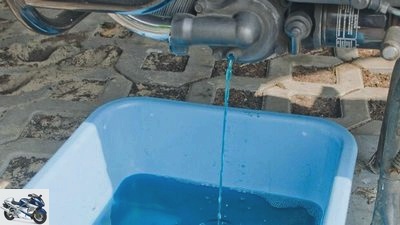
Ralf Petersen
No challenge – changing the coolant.
For refilling (deviations possible depending on the design), the drain plug with a new seal and the specified torque is screwed in first. Then you fill the radiator completely with coolant, start the engine (this will vent the system) and carefully top it up until the level doesn’t drop any more. It helps if you press any air out of the hoses / 12 / with your fingers. Sometimes there is also a vent valve. If the fluid level remains constant, screw the radiator cap back on, but let the engine run. At best, until the electric fan starts up briefly. Logical: If the tank has been dismantled, you have to think about a way to supply the fuel.
The entire cooling system is then thoroughly checked for leaks and the coolant level in the expansion tank is checked and, if necessary, corrected. After the first trip, it is advisable to check it again. Caution: If the engine is cold, you should only fill up to the middle position, as the cooling water expands at operating temperature! If you have accidentally filled in too much coolant, it can be sucked off with a syringe and hose. Coolant is poisonous and must therefore be disposed of properly, preferably at the recycling center.
Thermostat check
If the engine only warms up relatively late or, on the contrary, it gets too hot quickly, this may be due to a defect in the thermostat. Depending on the design, it can be more or less easily removed in order to test its proper function. With the NTV it is conveniently integrated in the radiator cap. A camping stove can be used for testing. To do this, the thermostat is immersed in the water without it touching the edge of the vessel. Then the water is heated: from 80 degrees the thermostat should open slowly, at 95 degrees it should reach a valve lift of at least eight millimeters after five minutes. Take care when measuring: only remove the thermostat with pliers (risk of burns).
Improvements
If the cooling water is overheated, e.g. B. in city traffic, the electric fan switches on automatically from around 100 degrees. In addition to the sensible control of the oil and water temperature, you can not only install two additional instruments in the motorcycle, but also connect the cable to the thermal switch to ground via an additional switch. This enables the fan to be switched on manually at an early stage in the event of high loads (mountains, full throttle driving) so that the water and oil temperature does not even reach the limit.
Winter operation
For extreme winter operation you can possibly also work with a (mobile) cover for the cooler, but if possible only in connection with an oil / water thermometer for control.
Related articles
-
Tips for mechanics – correct motorcycle chain maintenance
Photo: Ralf Petersen 13th pictures Ralf Petersen 1/13 / 1 / A typical lack of maintenance: everything sparkling clean, even the chain. Ralf Petersen 2/13…
-
Screwdriver tips for motorcycle seats
Ralf Petersen 13th pictures Ralf Petersen 1/13 Ralf Petersen 2/13 Ralf Petersen 3/13 Ralf Petersen 4/13 Ralf Petersen 5/13 Ralf Petersen 6/13 Ralf…
-
17th pictures archive 1/17 The BMW F 800 engine, with its oil ducts running through it, shows how complex the pressure circulating lubrication is….
-
Driving tips: Warm up the motorcycle properly
jkuenstle.de counselor workshop Driving tips: Warm up the motorcycle properly This is how it works: Warm up the motorcycle properly How to get your bike…
-
Engine cooling technology: Air cooling will soon be obsolete?
Photos: Manufacturer motorcycles Engine cooling technology: air cooling will soon be obsolete? Technology: engine cooling Air cooling will soon be…
-
Conversion tips exhaust systems
Hanselmann 8th pictures Debus 1/8 In principle, there are two options when the exhaust is to be replaced. Here is a completely new system from Akrapovic,…
-
Motorcycle exhaust systems from SR-Racing
fact 18th pictures fact 1/18 Sepp Bruckschlogl is the master of the pipes and head of SR-Racing. fact 2/18 Components of the silencer. fact 3/18 Shapes…
-
New Bosch motorcycle safety systems
Bosch 17th pictures Bosch 1/17 To make motorcycling even safer, Bosch is developing numerous new assistance systems. Bosch 2/17 Motorcycles should learn…
-
Motorcycle anti-lock braking systems in a comparison test
Jahn 13th pictures Jahn 1/13 The relations shift on the wet test track – in the truest sense of the word. Jahn 2/13 In conclusion, it can be said that…
-
PS reader question about motorcycle technology – cleaning the radiator
www.factstudio.de, Joachim Schahl 7th pictures archive 1/7 Picture gallery, technical question: cleaning coolers. Werner Koch 2/7 When the delicate…